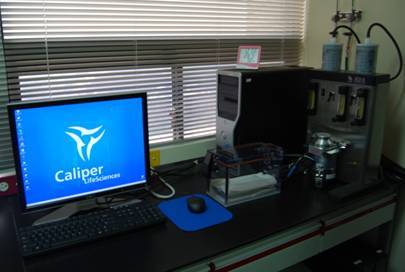Xenogen IVIS Spectrum Noninvasive Quantitative Molecular Imaging System
This system is an in vivo real-time imaging system by use of luciferase and is developed exclusively for laboratory animals and plants. Its hardware is designed upon two features: 1) fluorescence generation after stimulation from green fluorescence protein (GFP) and/or nanometer-fluorescent dyes; and 2) luminescence generation by luciferase; thus, researcher can observe the differences at certain time point of the same animal or plants, also its designs offers 3D image retrieve function. As to its software design, including functions as absolute quantification reference, detection for depth of signals, analysis of animal organ overlays and superimposition with images generated from other instruments etc., researcher can generate more precise and multiple-aspect image data for analysis.
Features of Xenogen IVIS Spectrum:
- This system adopts absolute quantification unit as photon/sec/cm2/sr to follow quantification analysis.
- This system adopts visible light detection system and detect sample image by two features: 1) fluorescence generation after stimulation from green fluorescence protein (GFP) and/or nanometer-fluorescent dyes; and 2) bioluminescence generation by luciferase. As so, safety is highly guaranteed since isotope probe is not required.
- This system includes luminescence/fluorescence 3D Surface Topography Reconstruction system。
- The software includes animal organ models that can offer overlays for analysis of sample depth.
- The system functions of image superimposition in high compatibility that can integrally superimpose with images of CT, MRI, PET and SPECT.
- The system also functions of laser positioning that can assist operator in precise positioning for placement of animal inside the machine, thus quantitative figures generated is more reliable.
- The system equips laser as an auxiliary for focus that is to adjust focus of lens according to the height of object detected by laser.
- The system also equips large size, as 1 inch, of CCD chips in high resolution, and thus as many as images of 5 mice can be synchronously generated.
- The standard equipments also include 28 types of fluorescence filter cube, 10 sets of excitation filter and 18 sets of emission filter.


Application of Xenogen IVIS Spectrum:
- Functional genomics, such as gene regulation and expression and protein-protein interactions (PNAS 9814595)
- Infectious disease study and establishment of animal models (J. Virol. 76, 12149)
- New drug R&D, such as drug metabolism and pharmacokinetics etc. (Mol Pharmacol 62;439)
- Medical research of cancer and tumor, and establishment of animal models (Cancer Res. 62, 1862)
- Drug function/ safety study/Taxicological Risk Assessment (J Mol Med 80;655)
- Organ transplantation study (Circulation. 108, 1302)
- Gene therapy/cell-therapy-related study /stem cell study (Blood. 102, 3478)
- RNAi (Nature, 418,38-39)
- Protein-protein-interaction-related study
- Pathogen-related study of animals and plants







